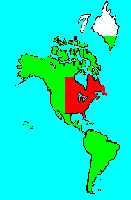SPECIES INFO
Rusty-patched bumble bee (Bombus affinis) was originally found from eastern Canada south to the Carolinas, and further south in the southern Appalachian Mountains to northern Georgia. This was also found west to Minnesota and south to Iowa. However, since about 1997 very few records are known for this species, and those records are mostly in Illinois, Indiana, Wisconsin, and Ontario. This species has now been given legal protection.
Although most males, and some workers have a brown stripe on the abdomen, the queen appears to lack this stripe.
In northern Illinois in 2017 in conjunction with the listing of this species, a highway construction project was halted until it was verified the rusty-patched bumble was not in the immediate area.The bumble-bee genus (Bombus) contains about 250 species found over a wide area in the world. Many species in Eurasia, North America, and South America are in serious decline. The United States is home to about 46 species in this genus. These bees are easy to recognize with the robust size, and typically black and yellow pattern.
These bees are important plant pollinators, and it is estimated that over one million colonies are sold worldwide each year. A book entitled "Bumble Bees of North America" published in 2014 is an excellent reference.
Honey and Bumble Bees (Family Apidae) are very important economically for both their honey and their role in plant pollination.
Apidae Family (bees) contains over 3,500 species bees living in North America.
Hymenoptera Order contains the ants, wasps, and bees. There are more than one hundred thousand species in this order in the world. The United States has approximately sixteen thousand species. The larvae resemble caterpillars or maggots. Many of the species in this order are social with different tasks performed by different members of the colony.
Insects (Class Insecta) are the most successful animals on Earth if success is measured by the number of species or the total number of living organisms. This class contains more than a million species, of which North America has approximately 100,000. (Recent estimates place the number of worldwide species at four to six million.)
Insects have an exoskeleton. The body is divided into three parts. The foremost part, the head, usually bears two antennae. The middle part, the thorax, has six legs and usually four wings. The last part, the abdomen, is used for breathing and reproduction.
Although different taxonomists divide the insects differently, about thirty-five different orders are included in most of the systems.
The following abbreviated list identifies some common orders of the many different orders of insects discussed herein:
Odonata: - Dragon and Damsel Flies
Orthoptera: - Grasshoppers and Mantids
Homoptera: - Cicadas and Misc. Hoppers
Diptera: - Flies and Mosquitoes
Hymenoptera: - Ants, Wasps, and Bees
Lepidoptera: - Butterflies and Moths
Coleoptera: - Beetles
Jointed Legged Animals (Phylum Arthropoda) make up the largest phylum. There are probably more than one million different species of arthropods known to science. It is also the most successful animal phylum in terms of the total number of living organisms.
Butterflies, beetles, grasshoppers, various insects, spiders, and crabs are well-known arthropods.
The phylum is usually broken into the following five main classes:
Arachnida: - Spiders and Scorpions
Crustacea: - Crabs and Crayfish
Chilopoda: - Centipedes
Diplopoda: - Millipedes
Insecta: - Insects
There are several other "rare" classes in the arthropods that should be mentioned. A more formal list is as follows:
Sub Phylum Chelicerata
C. Arachnida: - Spiders and scorpions
C. Pycnogonida: - Sea spiders (500 species)
C. Merostomata: - Mostly fossil species
Sub Phylum Mandibulata
C. Crustacea: - Crabs and crayfish
Myriapod Group
C. Chilopoda: - Centipedes
C. Diplopoda: - Millipedes
C. Pauropoda: - Tiny millipede-like
C. Symphyla: - Garden centipedes
Insect Group
C. Insecta: - Insects
The above list does not include some extinct classes of Arthropods such as the Trilobites.
Animal Kingdom contains numerous organisms that feed on other animals or plants. Included in the animal kingdom are the lower marine invertebrates such as sponges and corals, the jointed legged animals such as insects and spiders, and the backboned animals such as fish, amphibians, reptiles, birds, and mammals.


